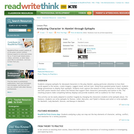
Students create epitaphs for characters from a tragedy, such as "Hamlet".
- Subject:
- English Language Arts
- Material Type:
- Activity/Lab
- Lesson Plan
- Provider:
- ReadWriteThink
- Provider Set:
- ReadWriteThink
- Date Added:
- 09/25/2013

Students create epitaphs for characters from a tragedy, such as "Hamlet".
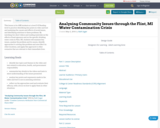
This lesson is for ABE students at a level D-E Reading level to practice identifying key points in video and text and analyzing the causes and effects of social issues, and identifying solutions to these problems. By watching two short videos and reading materials on the effects of lead exposure and on the specific drinking water crisis in Flint, MI, students will examine key issues, analyze the problem and its causes, identify approaches to solving this problem and ones like it in other locations, and apply this approach to other scenarios that are relevant to their immediate lives.

Students are often asked to perform speeches, but rarely do we require students to analyze speeches as carefully as we study works of literature. In this unit, students are required to identify the rhetorical strategies in a famous speech and the specific purpose for each chosen device. They will write an essay about its effectiveness and why it is still famous after all these years.
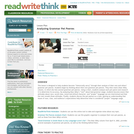
By analyzing Dear Abby's rant about bad grammar usage, students become aware that attitudes about race, social class, moral and ethical character, and "proper" language use are intertwined.
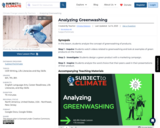
SYNOPSIS: In this lesson, students analyze the concept of greenwashing of products.
SCIENTIST NOTES: This lesson introduces students to greenwashing and then presents Trader Joe’s as a case study. Students are tasked with designing their own green product and an accompanying marketing plan. The lesson informs students how companies can mislead them with products that only seem environmentally friendly and gives tips on how to spot greenwashing. This lesson is recommended for teaching. (The only small issue with this lesson is that an advertisement for a VPN is included in the Trader Joe’s case study video, but that's just part of using resources from YouTube.)
POSITIVES:
-Students create a product and then see what effect their product has on consumers. This will show students how greenwashing occurs within marketing campaigns.
-This lesson includes media literacy components.
ADDITIONAL PREREQUISITES:
-Teachers should be familiar with the term greenwashing and be able to explain what is regulated by the FDA and what is not regulated by the FDA.
-Teachers should understand the term green is not regulated by the FDA, but the term organic is regulated by the FDA.
DIFFERENTIATION:
-The term greenwashing is an abstract concept, so it may be hard for students to grasp. Showing other examples of greenwashing may help students better understand the concept.
-Teachers can show students different labels or advertisements and have students analyze whether they consider each example greenwashing or not.

Images can be a useful component in any subject. This lesson will guide students through an analysis of an image. Students will use critical thinksing skills to interpret an image. Students will then generate a hypothesis about the source and construct questions for further investigation.
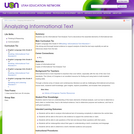
In this lesson students use the Informational Text Analysis Tool to deconstruct the essential elements of informational text. Informational text is more important to teachers than ever before, especially with the rise of the new Core standards. The Library of Congress is an excellent resource for finding and using texts to build students' reading skills.Through a diverse array of classic and contemporary literature as well as challenging informational and primary source texts, students build knowledge, gain insights, explore possibilities, and broaden their perspective.

Can a person be both admirable and flawed at the same time? In this lesson, students will look more closely at the character of Okonkwo. Students will figure out what his most admirable qualities are, as well as some of his flaws. They will also decide whether Okonkwo has the potential to be a tragic hero.
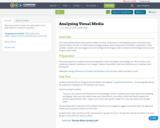
This lesson guides students through analysis of non-print media as a vehicle for argument.
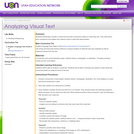
In this lesson Students individually consider a visual text and draw conclusions based on what they see. They write about their conclusions and explain the evidence used to make that determination. Students will be able to analyze a visual text. Students will be able to develop and support a claim about the visual text based on evidence found in the text.
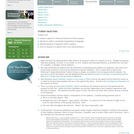
After gaining skill through analyzing a historic and contemporary speech as a class, students will select a famous speech from a list compiled from several resources and write an essay that identifies and explains the rhetorical strategies that the author deliberately chose while crafting the text to make an effective argument. Their analysis will consider questions such as: What makes the speech an argument?, How did the author's rhetoric evoke a response from the audience?, and Why are the words still venerated today?

Students will analyze photos for specific details that reveal the owner of a specific room.Then the analysis will include literature but will focus on literary devices and connotations.Also, students will have the opportunity to summarize text and then use evidence to support specific connotations.

Students analyze images of Oscar Wilde used to publicize his 1882 American lecture tour. They then compare a caricature to another researched image, sharing this analysis in a podcast.

It is important for students to know how to evaluate messages conveyed by the news media. Exploration of the artistic techniques used in political cartoons leads to critical questioning.
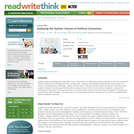
Students explore and analyze the techniques that political (or editorial) cartoonists use and draw conclusions about why the cartoonists choose those techniques to communicate their messages.

This interactive PDF explains the four types of writing and their applications, and provides some free examples.
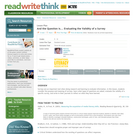
In this lesson, students learn to ask the right questions about the validity of surveys.

There's no question that students will be able to compose good survey questions by the end of this lesson.
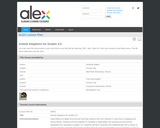
HyperSlides are digital lessons/units that help students learn the material in a way that is engaging and inquiry-based. Students will work together to complete a HyperSlides unit centering around animal adaptations for standards in grades 3-5. Students will work creatively and collaboratively with a variety of Course of Study standards that engage students through using Google Slides and a Hyperlinks to assist in the understanding of animal adaptations. This project will take several class periods to complete. After an introduction to the Hyperslides, students are encouraged to work at their own pace, but Hyperslides can be assigned on a daily basis. This Lesson Plan was created in partnership with the Birmingham Zoo.
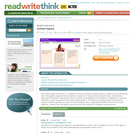
Supporting inquiry-based research projects, the Animal Inquiry interactive invites elementary students to explore animal facts and habitats using writing prompts to guide and record their findings.